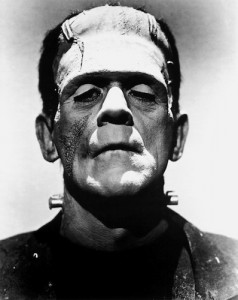Stitching Scenes Together: The “Frankenstein” Writing Method
You know that moment while you’re writing a story, carefully following the plot in your mind, when you’re suddenly struck with inspiration for a specific point in the middle of the narrative? It’s that moment when the details start stringing themselves together in your head to form the perfect scene, word for word, exactly the way you want to read it back on the page, and you know you have to write it down before the moment passes and the right words are lost for good. Does that sound familiar at all?
OK, maybe it doesn’t happen to you, but it certainly happens to me all the time. Maybe you’re one of those writers who can plow through the events of a story in the order they’re supposed to happen, who can stick faithfully to an outline from the hook in the first paragraph to the final lines of the very last page. I’m sure there are writers who manage to write in a “straight line”. But I’m not one of them. I zig-zag. I shuffle. I start in the middle and shift between the beginning and the end. I write backwards (maybe not in the literal sense that Leonardo da Vinci could, but you get my point). Basically, I write every which way but straight.
So how do I turn these scattered pieces into a story? In a similar way that a famous fictional scientist turned separate body parts into his iconic monster: by “stitching” them together.
Collecting Parts

Frankenstein’s Monster (Frankenstein, 1931)
Everyone at one time or another has heard the name Frankenstein. Since the first publication of Mary Shelley’s novel in 1818, the name has become practically a legend in the horror and science fiction genres, and today is even one of the more obvious monster themes associated with Halloween. Even if most people haven’t read the book, many have probably seen at least part of the 1931 film adaptation (especially fans of the Universal Monsters movie series), and it’s on this interpretation of the creature that I based my writing method. While Shelley’s novel leaves the process of the monster’s creation ambiguous, the movie has Dr. Frankenstein build it out of collected limbs and organs that he pieces together into a human body. As for what happens after he brings the body to life, suffice it to say it all goes downhill from there.
Sometimes I like to think of my stories as my own little Frankenstein’s monsters, not in the sense that they’ll unleash untold horror on the world (which some of them might, though it’s too soon to tell), but in the sense that many of them are comprised of prewritten pieces that I later connected by inserting more words in between. Some of them are only a couple of lines long, some are a few paragraphs, and some take up more than a page. But they all come to me “out of turn”.
I spend a lot of time daydreaming about my stories, and a common result of this is the inspiration for a perfectly worded sequence that I haven’t yet reached in the main draft. In order to hold on to these ideas, I often keep a separate file on my computer where I can type them out while they’re still fresh in my mind. After making a note of it, I don’t usually read a scene again until I’ve worked my way up to that point in my story. That’s when the fun of stitching begins.
Stitching the Parts Together
When I have my individual scenes laid out, the next step is to insert them into my stories. While working on the main draft, I’ll eventually come to that part of a story that I had already written in a moment of inspiration. All I have to do then is copy the piece from the separate file I’ve made and paste it into the draft to move on from that point. Simple as that. Usually.
The thing is, it doesn’t necessarily end there. Sometimes after pasting it in, I find that a prewritten scene doesn’t quite fit into the rest of the narrative the way I had anticipated, either because of simple inconsistencies in style or minor details that I had changed since first writing the separate piece. To solve this, I edit the selection to accommodate the newly inserted sequence, revising details in the narrative and/or the added part, until everything fits together like the pieces of a puzzle.
The method doesn’t always work the same way. There are times when I’m struck with the inspiration to write two different scenes that I later realize are close enough in the story’s sequence of events that I can just stitch them together right there on the spot. Other stories of mine have been born from drafts that were nothing but a collection of separate scenes in which I eventually started closing the gaps. But any way I choose to put together the events of a narrative, it’s rarely in the right order. In much the same way I imagine Dr. Frankenstein must have worked to fit all his collected organs into a fully functional body (especially in the novel, where the creature is eight feet tall!), I work to stitch my scattered ideas into complete stories that function well as fiction.
So what writing method works best for you? Do your stories usually unravel in a straight line, or do you stitch them together from separate pieces?


Recent Comments